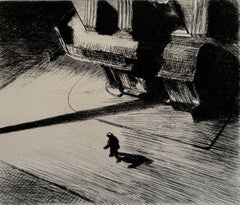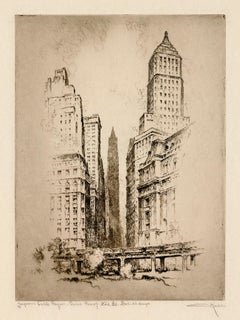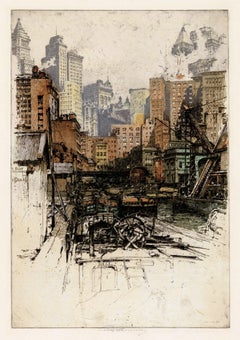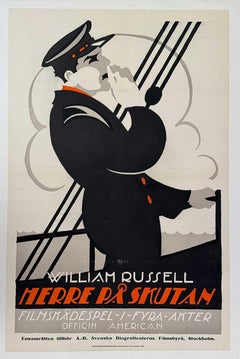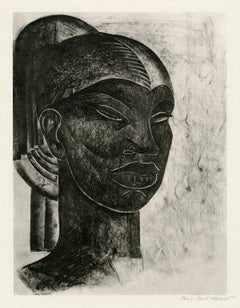1920s Figurative Prints
to
827
1,077
215
59
21
37
Overall Width
to
Overall Height
to
544
194
136
99
39
18
15
7
1
1
1
169
56
39
34
31
3,543
7,599
26,150
6,827
294
652
1,429
1,266
1,341
2,295
3,788
5,366
2,814
1,277
3,037
1,071
331
7
1,182
737
619
463
412
306
304
148
81
66
58
53
52
46
46
43
33
33
31
22
576
346
333
128
120
133
418
764
519
Period: 1920s
Night Shadows
By Edward Hopper
Located in Storrs, CT
Night Shadows. 1921. Etching. Levin 82. 7 x 8 3/8 (sheet 10 x 13 7 1/16).s Series: Six American Etchings: The New Republic Portfolio, 1924. Edition approximately 500-600. Illustrate...
Category
American Modern 1920s Figurative Prints
Materials
Etching
$48,000 Sale Price
20% Off
'The Gateway to the New World' — Vintage New York City
By Otto Kuhler
Located in Myrtle Beach, SC
Otto Kuhler, 'The Gateway to the New World', etching (artist's proof), edition 16, 1926, Kennedy 25. Signed in pencil and annotated 'Japan Silk Paper - Trial Proof - Ltd. Ed. Del. et...
Category
American Modern 1920s Figurative Prints
Materials
Etching
'Coenties Slip' — Lower Manhattan, Financial District
Located in Myrtle Beach, SC
Luigi Kasimir, 'Coenties Slip', color etching with aquatint, 1927, edition 100. Signed in pencil. Dated in the plate, lower right. Annotated 'NEW YORK HANOVER SQUARE (COENTIES SLIP)'...
Category
American Modern 1920s Figurative Prints
Materials
Etching, Aquatint
Original The Sea Master Herre på Skutan 1920 Swedish art deco movie poster
Located in Spokane, WA
Original Swedish movie poster, The Sea Master. (Herre på Skutan).. Archival linen backed in good condition, ready to frame. The USA silent movie was produced in 1917 but released in ...
Category
Art Deco 1920s Figurative Prints
Materials
Lithograph
Paris : Saint Michel Bridge - Original Etching (Duthuit-Matisse #108)
Located in Paris, IDF
Henri MATISSE (1869-1964)
Paris : Saint Michel Bridge, 1927
Original etching
Printed signature in the plate
Limited to 225 copies
On BFK Rives vellum 25 x 33 cm (c. 9.8 x 12.9 in)...
Category
Modern 1920s Figurative Prints
Materials
Etching
Portrait of an African Woman — 1920s Modernism
Located in Myrtle Beach, SC
Boris Lovet-Lorski, Untitled (Portrait of an African Woman), lithograph, edition 250, 1929. Signed and numbered 13 in pencil. Number 13 of Volume 2, a series of 10 lithographs publis...
Category
Art Deco 1920s Figurative Prints
Materials
Lithograph
$760 Sale Price
20% Off
SCARCE EARLY OROZCO - CABEZA DE MUJER -
Located in Santa Monica, CA
JOSE CLEMENTE OROZCO (1883 – 1949)
CABEZA DE MUJER, ( Woman's Head: Mexican Woman) 1929 (Orozco 9)
Lithograph, signed and numbered 23/50. in pencil. Pri...
Category
Realist 1920s Figurative Prints
Materials
Lithograph
'Brooklyn Bridge' — Iconic New York City Landmark
Located in Myrtle Beach, SC
Luigi Kasimir, 'Brooklyn Bridge', color etching with aquatint, 1927, edition 100. Signed in pencil.
A superb impression, with fresh colors, on heavy, cream wove paper; with margins...
Category
American Modern 1920s Figurative Prints
Materials
Etching, Aquatint
Au Japon
Located in Fairlawn, OH
Au Japon
Pochoir (Stencil Print), 1925
Signed by the artist in pencil lower right (see photo)
Signed in the image lower left (see photo)
Stamped verso: Made in France
Note: The artis...
Category
Art Deco 1920s Figurative Prints
Materials
Screen
St. Stephen's Cathedral in Vienna - Hand Colored Cityscape Lithograph
Located in Soquel, CA
Detailed and dramatic hand-colored etching by Luigi Kasimir (Austrian, 1881-1962). St. Stephen's cathedral towers above the streets of Vienna, with people going about their daily bus...
Category
Photorealist 1920s Figurative Prints
Materials
Paper, Watercolor, Lithograph
Leda and the Swan
Located in West Hollywood, CA
Presenting a monumental original etching by French artist Albert Decaris. Decaris won many honors in France during his extensive career.
"Leda and the Swan", depicts the mythologi...
Category
1920s Figurative Prints
Materials
Etching
Tall Nude with a Fan - Original etching (Kornfeld #39), 1924
By Marc Chagall
Located in Paris, IDF
Marc Chagall (1887-1985)
Tall Nude with a Fan, 1924
Original etching
On vellum 34 x 51,5 cm (c. 14 x 20 in)
REFERENCE: Catalog raisonne Kornfeld #39
INFORMATION : Beautiful proof...
Category
Modern 1920s Figurative Prints
Materials
Etching
Tempête à Nice - PhotoLithograph after Henri Matisse - 1920
Located in Roma, IT
Tempête à Nice is a photolithograph realized in 1993 after Henri Matisse.
Signed on the plate
On Milano handmade paper.
Very good conditions.
Category
Modern 1920s Figurative Prints
Materials
Lithograph
Sculpteur devant sa Sculpture - Etching by Pablo Picasso - 1927
Located in Roma, IT
B/w etching on Hollande Van Gelder Paper, with margins.
Belongs to the series "Le Chef-d'Oeuvre Inconnu".
Hand Signed and numered in bistre ink. Edition of 10/99, aside from the port...
Category
Cubist 1920s Figurative Prints
Materials
Paper, Etching
GEFALLEN (Killed in Action)
Located in Santa Monica, CA
KATHE KOLLWITZ (1867-1945)
GEFALLEN (Killed in Action) 1920 (Klipstein 153 (1st state, a of c of 2 states)
Lithograph on laid paper. Image 16 ¼ x 15 ¼ inches, Large Full Sheet, 25 ½...
Category
Expressionist 1920s Figurative Prints
Materials
Lithograph
'Snow Shovellers, New York' — American Modernism
Located in Myrtle Beach, SC
Clare Leighton, 'Snow Shovellers, New York', 1929, wood engraving, edition 45, Boston Public Library 146. Signed, titled, and numbered '29/45' in pencil. A...
Category
American Modern 1920s Figurative Prints
Materials
Woodcut
'The Furnace' — American Expressionism
By Otto Kuhler
Located in Myrtle Beach, SC
Otto Kuhler, 'The Furnace', drypoint, edition 26, 1924, Kennedy 5. Signed and annotated 'Drypoint. Ltd Ed. Del. et imp.' in pencil. Titled in pencil, in the bottom center sheet edge....
Category
American Modern 1920s Figurative Prints
Materials
Drypoint
Early 20th Century Social Realism Etching by John Sloan -- Bandits Cave
Located in Soquel, CA
1920 Social Realism Etching by John French Sloan titled "Bandits Cave"
Compelling etching by John Sloan (American 1871 - 1951), 1920 during first year of prohibition showing a estab...
Category
Ashcan School 1920s Figurative Prints
Materials
Laid Paper, Etching
Norman Rockwell "Family Tree" Lithograph
Located in New York, NY
Norman Rockwell (American, 1894-1978)
Family Tree
Original painting produced 1959, this print published 1959 in Japan by The Curtis Publishing Company
Lithograph
Sight: 19 1/4 x 13 3...
Category
American Modern 1920s Figurative Prints
Materials
Lithograph
Original Ingen Rast, Ingen Ro No Rest No Peace Hobbs in a Hurry Silent movie
Located in Spokane, WA
Original Ingen Rast, Ingen Ro, a Swedish vintage silent movie poster from 1920. Translated, it means No Rest, No Peace. However, the American titl...
Category
Art Deco 1920s Figurative Prints
Materials
Lithograph
Composition, Les Biches, Marie Laurencin
Located in Auburn Hills, MI
Lithograph and stencil on papier vélin des Manufactures d'Arches paper. Unsigned and unnumbered, as issued. Good Condition. Notes: From the volume, Les Biches, 1924. Published by Édi...
Category
Modern 1920s Figurative Prints
Materials
Lithograph, Stencil
$2,796 Sale Price
20% Off
Life in the Sea : Mermaid Maternity - Original wooodcut, Handsigned & Numbered
Located in Paris, IDF
Henri AMEDEE-WETTER (1869-1929)
Life in the Sea : Mermaid Maternity, 1922
Original woodcut
Handsigned in pencil
Numbered /105
On vellum 32.5 x 25.5 cm (c. 13 x 10 in)
Bears the blin...
Category
Modern 1920s Figurative Prints
Materials
Woodcut
Le Chapeau Epinglé - Etching by Pierre Auguste Renoir - 1921
Located in Roma, IT
Le chapeau épinglé (La fille de Berthe Morisot et sa cousine) 3e planche. Etching realized by Renoir in 1894.
Image dimension 11.5x8 cm. / sheet dimension 33.2x15.1 cm.
The final s...
Category
Impressionist 1920s Figurative Prints
Materials
Etching
Hiding Place, Framed Art Nouveau Etching by Louis Icart
By Louis Icart
Located in Long Island City, NY
Artist: Louis Icart, French (1888 - 1950)
Title: Hiding Place
Year: 1927
Medium: Etching, signed in pencil
Image Size: 18 x 14.5 inches
Size: 19 x 15.5 in. (48.26 x 39.37 cm)
Frame S...
Category
Art Nouveau 1920s Figurative Prints
Materials
Etching
Max Weber Woodcut Print from "Primitives" Poetry Book Signed
By Max Weber
Located in Detroit, MI
ONE WEEK ONLY SALE
This woodcut print is an expressionist print on one of the poems from Max Weber's poetry collection "Primitives: Poems and Woodcuts". This work is signed in penci...
Category
Expressionist 1920s Figurative Prints
Materials
Woodcut
Faust : Margueritte and Devil - Original etching, Handsigned
By Louis Icart
Located in Paris, IDF
Louis Icart
Faust : Margueritte and Devil
Original etching with aquatint
Signed in pencil
Blind stamp of the editor on the bottom left corner
On vellum 62 x 45 cm (c. 25 x 18 in)
...
Category
Art Deco 1920s Figurative Prints
Materials
Etching, Aquatint
Original LONDON MIDLAND & SCOTISH RAILWAY - LMS, 1925 vintage railroad poster
Located in Spokane, WA
Original London Midland and Scottish Railway (LMS) vintage Art Deco railway poster from 1925. The artist is Raymond Virac. Archival linen-backed and in excellent condition, ready to ...
Category
Art Deco 1920s Figurative Prints
Materials
Lithograph
Erotic Scene - Lithograph by Albert Marquet - 1920s
Located in Roma, IT
Erotic Scene is a beautiful lithograph on ivory-colored paper, realized in the 1920s by Albert Marquet (Bordeaux, 1875 - Paris,1947).
Monogrammed on the plate on the lower margin. ...
Category
Modern 1920s Figurative Prints
Materials
Lithograph
E. Strache, Handzeichnungen folio, "Female Model, Seated" Collotype plate
Located in Chicago, IL
After Egon Schiele (1890 – 1918), AUSTRIA
“ART CANNOT BE MODERN, ART IS PRIMORDIALLY ETERNAL.” -SCHIELE
Defiantly iconoclastic in life and art, Egon Schiele is esteemed for his mas...
Category
Vienna Secession 1920s Figurative Prints
Materials
Paper
Vintage Etching - Love & Ballet
By Ernst Oppler
Located in Houston, TX
Romantic black and white etching of a pair of ballet dancers performing on stage by artist Ernst Oppler (1867-1929), circa 1920. Signed lower right, numbered 88 of 100 lower left.
...
Category
1920s Figurative Prints
Materials
Etching, Ink, Paper
"Portrait of a Boy (Rupert Doone)" original woodcut
Located in Henderson, NV
Medium: original woodcut. Catalogue reference: Colnaghi 142. Published in London in 1921 by Herbert Furst at the Little Art Rooms for inclusion in the "Modern Woodcutters 4" volume, ...
Category
Expressionist 1920s Figurative Prints
Materials
Woodcut
Le "FLIP" Soap original vintage French antique poster
Located in Spokane, WA
Original French vintage poster.
le "Flip" Soap.
This fun image shows the tube of 'Flip" pushing away the shaving bowl, towel, and shaving brush. I...
Category
Art Deco 1920s Figurative Prints
Materials
Lithograph
$1,279 Sale Price
20% Off
'Dancing' — 'les années folles' Paris Masterwork, 1928
Located in Myrtle Beach, SC
Yasuo Kuniyoshi, 'Dancing', lithograph, 1928, edition 30, Davis L-29. Signed, dated, and numbered '8/30' in pencil. A superb, richly-inked impression, printed on cream chine appliqué on heavy off-white wove backing; the full sheet with wide margins (1 3/8 to 4 7/8 inches), in excellent condition. Printed by Desjobert, Paris. Scarce. Matted to museum standards, unframed.
Impressions of this work are in the collections of the Museum of Modern Art, Whitney Museum of Modern Art, and Yasuo Kuniyoshi Museum (Japan).
ABOUT THIS WORK
The French economy boomed from 1921 until the Great Depression reached Paris in 1931. This period called 'Les années folles' or the 'Crazy Years', saw Paris reestablished as a capital of art, music, literature, and cinema. Paris in the 1920s and 1930s was the home and meeting place of some of the world's most prominent painters, sculptors, composers, dancers, poets, and writers. For those in the arts, it was, as Ernest Hemingway described it, "A moveable feast". Paris was home to an exceptional number of galleries, art dealers, and a network of wealthy patrons who offered commissions and held salons.
Pablo Picasso, perhaps the most famous artist in Paris, shared renown with a remarkable group of others, including the Romanian sculptor Constantin Brâncuși, the Belgian René Magritte, the Italian Amedeo Modigliani, the Russian émigré Marc Chagall, the Catalan and Spanish artists Salvador Dalí, Joan Miró, Juan Gris, and the German surrealist...
Category
American Modern 1920s Figurative Prints
Materials
Lithograph
'The Spirit of the Wine' — Japanese Legend from the Famed Chikamatsu Series
Located in Myrtle Beach, SC
Hokuto Tamamura (1893-1951), 'The Spirit of the Wine' (Shuten Dōji) - from Dai Chikamatsu Zenshu (The Complete Works of Chikamatsu)', color woodblock, 1923-26. Signed 'Hokuto'. A fin...
Category
Showa 1920s Figurative Prints
Materials
Woodcut
Art Nouveau Poster "Marmorhouse (Der Teufel und Die Circe) by Josef Fenneker
Located in Chicago, IL
The painter, graphic artist, production and set designer, Josef Fenneker, is one of the most important representatives of artistic film posters of the 1910s and 1920s. He was commissioned primarily by Berlin’s Marmorhaus cinema, which was located on Kurfürstendamm and known for its first releases, as well as by Berlin film production...
Category
Expressionist 1920s Figurative Prints
Materials
Lithograph
Au Lido - Pochoir by G. Barbier - 1920
Located in Roma, IT
This pochoir belongs to the portfolio 'Le Bonheur du Jour', by George Barbier.
A very fine work of one of the most important and famous european illustrators of Art Deco, whose infl...
Category
Art Deco 1920s Figurative Prints
Materials
Stencil
$2,018 Sale Price
30% Off
Paris : Parisian Club - Original Etching, 1927 (Juffermans #JE4)
Located in Paris, IDF
Kees VAN DONGEN (1877-1968)
Paris : Parisian Club, 1927
Original etching
Unsigned
Limited to 225 copies
On BFK Rives vellum 33 x 25 cm (c. 12.9 x 9.8 in)
REFERENCE : Catalogue ra...
Category
Modern 1920s Figurative Prints
Materials
Etching
Matisse, Crayon, Dessins de Henri-Matisse (after)
Located in Auburn Hills, MI
Lithograph on vélin Lafuma Navarre paper. Unsigned and unnumbered, as issued. Good Condition; never framed or matted. Notes: From the album, Dessins de Henri-Matisse, 1925. Published...
Category
Modern 1920s Figurative Prints
Materials
Lithograph
$956 Sale Price
20% Off
Composition, Les Biches, Marie Laurencin
Located in Auburn Hills, MI
Lithograph and stencil on papier vélin des Manufactures d'Arches paper. Unsigned and unnumbered, as issued. Good Condition. Notes: From the volume, Les Biches, 1924. Published by Édi...
Category
Modern 1920s Figurative Prints
Materials
Lithograph, Stencil
$2,796 Sale Price
20% Off
Portrait de Jean Desbordes - Lithograph by Jean Cocteau - 1929
By Jean Cocteau
Located in Roma, IT
Jean Cocteau, Portrait de Jean Desbordes is a Lithograph on vélin pur fil des Papeteries du Marais, realized by Cocteau in 1929.
Belongs to the suite "25 Dessins d'Un Dormeur", publ...
Category
Modern 1920s Figurative Prints
Materials
Lithograph
Art deco handcolored woodcut on paper - Walking black panther by Gaston Suisse
Located in Les Acacias GE, GE
Gaston Suisse (1896-1988)
Panthère noire dans les bambous, 1927
Gravure sur bois, sur papier Velin de Van Gelder.
Rehaussé aux lavis d’encre de Chine par l’artiste
Signé en bas à gauche et daté 1927 en bas à droite
Black panther in a forest of bamboos, 1927
A handcolored woodcut on Velin de Van Gelder paper
Signed and dated 1927
Bibliographie /Literature
Gaston Suisse, splendeur du laque art déco. Emmanuel Bréon. Somogy Éditions d'art, Paris 2013, reproduite page 105 (un autre exemplaire reproduit)
The artist made a wood engraving of which he made about twenty prints himself.
These proofs were not marketed as is, Gaston Suisse reworked each of the proofs using Indian ink washes in order to obtain different effects for each proof, which are thus unique original works.
Born in 1896 in a family of artists, his father Georges was a close friend of Siegfried Bing and a great lover of Japanese art and a bibliophile. He passed his taste for art to his son whom he often took to draw at the Botanic Garden . Around 1910, Gaston Suisse, who hasn't entered yet the artistic school, met Paul Jouve, then 18 years his elder, who was already famous.
In 1911, at the age of 17, he entered the National School of Decorative Art where he followed the teachings of Paul Renouard. Thanks to his knowledge and taste for the Japanese art, he chose lacquer painting as his specialty. His practice of this noble and demanding subject were so much appreciated that he was awarded with two gold medals in 1913 and 1914. Mobilized during the war , he joined the army and go in Salonika where he found his friend Jouve. In 1918, he finished his studies at the School of Applied Arts in order to perfect his training. He learned in particular the techniques of gilding and oxidation of metals. The first productions of Gaston Suisse, furniture and objects in lacquer with geometrical patterns, were an instant success and Suisse was appointed as member of Salon d'Automne in 1924, the very year of his first exhibition. Considered as an artist-decorator, his sincere and deep friendship with Jouve linked him in parallel with the groups of the animaliers of the Jardin des Plantes and became a close friend of Edouard-Marcel Sandoz. When travelling to Maghreb and Middle-East between 1923 and 1925, he produced numerous drawings representing antelopes, apes and fennec foxes...
Category
Art Deco 1920s Figurative Prints
Materials
India Ink, Woodcut
Kyoka-Tokaido - Woodcut after Utagawa Hiroshige -1925
Located in Roma, IT
Kyoka-Tokaido is an original modern artwork realized after Utagawa Hiroshige (1797 – 12 October 1858) in 1925.
Woodcut print Chuban Yokoe Format. Signed...
Category
Modern 1920s Figurative Prints
Materials
Woodcut
$315 Sale Price
24% Off
Original "Iolanthe" vintage stone lithograph vintage theater poster
Located in Spokane, WA
Original Iolanthe vintage theatre poster: Gilbert and Sullivan Iolante stone lithograph vintage poster. Museum linen backed. Clear, clean, bright. Grade A condition.
The poster features a central image of a character dressed in a traditional British Grenadier Guard uniform, complete with a bearskin hat. The character is depicted in a whimsical pose, which aligns with the comedic and satirical nature of the operetta. Above the main figure, there are smaller illustrations of various characters from the operetta, hinting at the fantastical and fairy-tale elements of the story. The title "Iolanthe" is prominently displayed in bold, stylized lettering at the bottom.
"Iolanthe, or The Peer and the Peri," is a comic opera by the famous duo W.S. Gilbert and Arthur Sullivan. The opera premiered on November 25, 1882, at the Savoy Theatre in London and is one of their most beloved works.
"Iolanthe" tells the story of fairy Iolanthe, who was banished from the fairy kingdom...
Category
Art Nouveau 1920s Figurative Prints
Materials
Lithograph
$268 Sale Price
20% Off
Symphony in White No. 2, The Little White Girl
Located in Fairlawn, OH
Clifford James (active 1900-1930)
After James Abbott NcNeill Whistler (1834-1903)
Symphony in White No. 2, The Little White Girl
Color mezzotint, 1922
Signed in pencil by James (see ...
Category
Pre-Raphaelite 1920s Figurative Prints
Materials
Mezzotint
Mexican Orchestra (joy of the people is captured in this celebratory festival)
Located in New Orleans, LA
"Mexican Orchestra" is one of the George Overbury Hart's largest pieces. It is #14 from a limited edition of 50. The image captures a festive event with hanging lanterns, an orches...
Category
American Modern 1920s Figurative Prints
Materials
Lithograph
The Dance - Lithograph by Raoul Dufy - 1920
By Raoul Dufy
Located in Roma, IT
The Dance is a vintage lithograph realized after Raoul Dufy in 1920.
Good conditions.
Edition of 110.
The artwork is depicted through confident strokes in a well-balanced composit...
Category
Modern 1920s Figurative Prints
Materials
Lithograph
$216 Sale Price
25% Off
The Pianist - Lithograph by Raoul Dufy - 1920
By Raoul Dufy
Located in Roma, IT
The Pianist is a lithograph realized by Raoul Dufy in 1920.
Good conditions.
Edition of 110. Unsigned and unnumbered as issued.
The artwork is depicted through confident strokes i...
Category
Modern 1920s Figurative Prints
Materials
Lithograph
$216 Sale Price
25% Off
Erotic Scene - Lithograph by Toyen - 1927
By Toyen
Located in Roma, IT
Erotic scene is an artwork realized by Toyen in 1923.
Mixed colored watercolored lithograph.
The artwork is an illustration from the book Pybrac written by Pierre Louÿs (1870-1925...
Category
Modern 1920s Figurative Prints
Materials
Lithograph
$405 Sale Price
25% Off
Hand Signed in Pencil Etching Cafe de Paris Visage de Maisons Maurice Vlaminck
Located in Surfside, FL
Maurice Vlaminck
Le Cafe de Paris, Pl. X, from Visage des Maisons, c. 1927 (Walterskirchen 132)
Etching on Van Gelder laid paper, signed in pencil, trial proof with the blindstamp o...
Category
Modern 1920s Figurative Prints
Materials
Etching
Matisse, Plume, Dessins de Henri-Matisse (after)
Located in Auburn Hills, MI
Lithograph on vélin Lafuma paper. Unsigned and unnumbered, as issued. Good Condition; never framed or matted. Notes: From the volume, Dessins de Henri-Matisse, 1925. Published by Édi...
Category
Modern 1920s Figurative Prints
Materials
Lithograph
$956 Sale Price
20% Off
"Dolly (I Love you!), " Original Color Lithograph Poster by the Clérice Frères
Located in Milwaukee, WI
"Dolly" is an original color lithograph poster by The Clérice Frères (The Clérice Brothers), signed within the composition on the lower left edge, just ...
Category
Art Deco 1920s Figurative Prints
Materials
Lithograph
Erotic Scene - Lithograph by Toyen - 1927
By Toyen
Located in Roma, IT
Erotic scene is an artwork realized by Toyen in 1927.
Mixed colored watercolored lithograph.
The artwork is an illustration from the book Pybrac written by Pierre Louÿs (1870-1925...
Category
Modern 1920s Figurative Prints
Materials
Lithograph
$405 Sale Price
25% Off
The Gargoyle and His Quarry
Located in Storrs, CT
The Gargoyle and His Quarry, Notre Dame. 1920. Etching.Fletcher 90. 7 1/8 x 5 1/4 (sheet 10 1/2 x 9 1/16). Gargoyle series #1. Edition 75. A rich impression printed on 'FJHead&Co' c...
Category
American Modern 1920s Figurative Prints
Materials
Drypoint, Etching
$2,750 Sale Price
21% Off
"Kopf" original woodcut
Located in Henderson, NV
Medium: original woodcut. This bold and striking Expressionist woodcut was printed in 1920 for Genius. Image size: 9 1/2 x 7 inches (240 x 180 mm). This original Rouveyre print is fr...
Category
Expressionist 1920s Figurative Prints
Materials
Woodcut
Matisse, Crayon, Dessins de Henri-Matisse (after)
Located in Auburn Hills, MI
Lithograph on vélin Lafuma Navarre paper. Unsigned and unnumbered, as issued. Good Condition; never framed or matted. Notes: From the album, Dessins de Henri-Matisse, 1925. Published...
Category
Modern 1920s Figurative Prints
Materials
Lithograph
$956 Sale Price
20% Off
'Karl Michel Exhibition' — German Expressionism
By Karl Michel
Located in Myrtle Beach, SC
Karl Michel, 'Austellung Karl Michel', woodcut, 1924, edition 20. Signed, dated, numbered 'op. 173' (the artist's inventory number) and '7/20' (the impression number/edition size) and annotated 'Vorgesdruck' (artist's proof) in pencil.
A fine, richly-inked impression on hand-made cream, wove paper, with full margins (1 1/16 to 1 1/2 inches); toning to the right sheet edge deckle, otherwise in good condition. With the artist's blind stamp in the bottom center margin. Designed and printed by the artist. Very scarce. Matted to museum standards (unframed).
An elegantly designed, dynamic exhibition announcement with the German copy in the block: 'Austellung Karl Michel – Deutsches Buchmuseum Leipzig/Zeitzer str 12, Berlin S.W. 61 Teltower str 33 / Buchschmuck/ Plakate/ Anzeige/ Schultzmarke/ Illustrations/ Ex Libris'. English translation: 'Karl Michel Exhibition – German Book Museum, Leipzig Zeitzer Street 12, Berlin, S.W. 61 Teltower St. 33. / Book Decoration / Posters / Announcements / Illustrations / Ex Libris.'
Image size 6 x 4 inches (152 x 102 mm); sheet size 8 1/16 x 5 1/2 inches (205 x 140 mm).
ABOUT THE ARTIST
Karl Michel (1889-1984) was a noted graphic designer and expressionist printmaker during Germany's pre-Nazi Weimar Republic (1919-1933). Michel’s work was the subject of a feature article in the influential German graphic design magazine 'Das Plakat' (The Poster) in 1920. An anti-war advocate, Michel created a suite of 12 wood engravings depicting his impressions of the humanitarian toll of WWII entitled ‘Humanitas’ (Humanity). The German publishing house Greifenverlag published the series in a folio of unsigned prints.
Michel’s graphic work is held in the permanent collections of the Auckland War Memorial Museum (New Zealand), Frederikshavn Kunstmuseum & Exlibrissamling (Denmark), Museum of Applied Arts (Budapest), The Robert Gore Rifkind Center for German Expressionist Studies at the Los Angeles County Museum of Art, and the German Expressionism...
Category
Expressionist 1920s Figurative Prints
Materials
Woodcut
Original Vini di Lusso Italian wine vintage poster 1922
By Plinio Codognato 1
Located in Spokane, WA
Original, Italian, Vini di Lusso lithograph vintage poster for fine wines. The Italian Society for Superior Wine. The image of a satyr (or Bacchus) getting ready to eat a group ...
Category
Art Deco 1920s Figurative Prints
Materials
Lithograph
Jèsus sera en Agonie jusqu'à la fin du Monde; from Folio Miserere, 1922
Located in Soquel, CA
Jèsus sera en Agonie jusqu'à la fin du Monde; from Folio Miserere, 1922
Aquatint of Jesus' crucifixion by Georges Rouault (French, 1871-1958). Jesus is depicted with his head lowere...
Category
Modern 1920s Figurative Prints
Materials
Aquatint
Henri Matisse, "Nu Au Coussin Bleu", lithograph, hand signed and numbered
Located in Chatsworth, CA
Henri Matisse
Nu Au Coussin Bleu, 1924
Original lithograph, hand signed in pencil
From the edition of 50 on arches vellum paper, numbered 5/50.
Sheet measures: 29.5 x 22 inches
Frame...
Category
Impressionist 1920s Figurative Prints
Materials
Lithograph
PKZ Man with Top Hat
By Johann Arnold
Located in New York, NY
PKZ vintage Poster (man in top hat). 1927, Color lithograph.
Lined on linen. PKZ has and still is an important department store in Zurich, Switzerland...
Category
Art Deco 1920s Figurative Prints
Materials
Lithograph
Recently Viewed
View AllMore Ways To Browse
Fernando Castro Pacheco
Angel Bracho
Botello Paul
David Schluss Serigraph
Grun Poster
Hajime Namiki
Harold Altman November
Hearts Suite Peter Max
Henry Theophile Hildibrand
Henry Wright Kerr
Herschel Levit
Hirschfeld Charlie Chaplin
Hirschfeld Marilyn
Hirschfeld Marx Brothers
Hisashi Otsuka
Invader Kit
Ivan Valtchev
James A Pritchard
